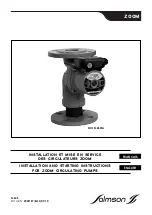
English (GB)
23
9. Fault finding the product
Before attempting to diagnose any fault, read and
observe the safety instructions in section
.
9.1 Megging
Observe all regulations applying to pumps
installed in potentially explosive
environments.
Make sure that no work is carried out in
potentially explosive atmosphere.
Before attempting to diagnose any fault:
– Make sure that the fuses have been
removed or the main switch has
been switched off.
– Make sure that the power supply
cannot be accidentally switched on.
– Make sure that all rotating parts have
stopped moving.
Fault
Cause
Remedy
1.
The pump does not run.
a)
The dry-running sensors are not
covered by the liquid.
After power-on, allow the liquid level
to rise until the dry-running sensors
are covered with liquid.
b)
Three-phase pumps only:
The pump is connected to the
power supply with a wrong phase
sequence.
Interchange L1 and L2.
c)
The fuses in the electrical
installation have blown.
Replace the blown fuses. If the new
fuses blow too, check the electric
installation and the power cable.
d)
Power supply failure, short circuit
or earth leakage in the cable or
the motor windings.
Have the cable and the motor
checked and repaired by a qualified
electrician.
e)
Fault in the motor electronics.
Have the motor checked and repaired
by a Grundfos service engineer.
f)
Deposits on the level or dry-
running sensors.
Clean the sensor(s).
2.
The pump starts, but
stops after a short while.
a)
The impeller is blocked by
impurities. Increased current
consumption in all three phases.
Clean the impeller.
b)
Increased current consumption
due to a large voltage drop.
Check that the supply voltage is
within the range. If not, reestablish
correct voltage supply.
c)
The liquid temperature is too
high.
Reduce the liquid temperature.
d)
The liquid viscosity is too high.
Dilute the liquid.
3.
The pump runs at
below-standard
performance and power
consumption.
a)
The outlet pipe is partly blocked
by impurities.
Clean the outlet pipe.
b)
The valves in the outlet pipe are
partly closed or blocked.
Check and clean or replace the
valves, if necessary.
4.
The pump runs, but
delivers no liquid.
a)
The outlet valve is closed or
blocked.
Check the outlet valve, and possibly
open and/or clean it.
b)
The non-return valve is blocked.
Clean the non-return valve.
Vent the pump.
c)
There is air in the pump.
Do not meg AUTO
ADAPT
pumps as this
may damage the built-in electronics.
















































